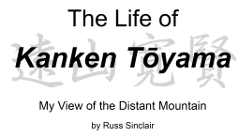About the Author
I started karate at age 12 in 1960 in Washington State, USA with sensei Morris Mack. We were under sensei Walter Todd. Our karatedō started out as Shūdōkan, because of a year and a half visit from Takahashi Kyōkō sensei, a member of Tōyama sensei’s Shūdōkan dōjō in Tōkyō.
After that visit, our instruction came mostly from Shōtōkan, Gōjū-ryū, and other sources, since we had no direct instruction from Tōyama sensei’s dōjō after Takahashi sensei’s visit.
I did sport karate on the US West Coast for the first few years of my training, because it was popular in those days, even though we heard that Tōyama sensei was against tournament karate.
I heard stories from Takahashi sensei about the great Kanken Tōyama Daishihan; that he taught traditional Okinawan karatedō that was much different than the modern sport karate that I grew up with. I moved to Tōkyō in 1969 to train at his dōjō and find out if the stories were true.
I didn’t have to work while I was living in Japan, so I spent all my time training and researching Tōyama sensei’s life and karatedō history. It was my dream to train at the headquarters dōjōs of all the main systems of karatedō in Japan so that I could see the differences and decide which form of karatedō I wanted to pursue long term. I visited other dōjōs in the daytime and any evening there was no training at Tōyama’s dōjō or I couldn’t meet up with my dōjō mates.
I visited the Japan Karate Association (Shōtōkan), Higaonna Morio’s Okinawa Gōjū-ryū dōjō in Yoyogi (Chinen Teruo was still there), Yamaguchi Gōgen of Japanese Gōjū-ryū, Ōyama Masutatsu of Kyokushinkai, Ōtsuka Hironnori’s Wadō-ryu, and even Mabuni Kenei’s Shitō-ryū dōjō in Ōsaka. All of those teachers spoke highly of Tōyama sensei.
I quickly realized that Tōyama Kanken’s karatedō was physically and culturally much different than the modern Japanese sport karate that had become popular in Japan and around the world.
Ichikawa Isao Hanshi trained with Tōyama Kanken from a young age and more continuously for more years than anyone. He was Tōyama sensei’s unofficial protégé. He moved to Vienna, Austria shortly after his teacher’s passing in 1966. Everyone at Tōyama’s dojo said, “If you want to understand Tōyama sensei’s karatedō you should train with Ichikawa Isao Hanshi. Shortly after returning to the USA I moved my family to Vienna to train with Toyama Kanken’s number one student. I have been dedicated to his Karatedō Dōshinkan ever since.
After two years in Vienna we moved back to the US. Ichikawa Hanshi conducted teaching tours twice each year in the USA, so I was able to continue training under him. He passed away in 1996. His brother and successor Ichikawa Nobuo Hanshi guided Karatedō Dōshinkan for more than twenty years. He gave me permission to write Tōyama Kanken’s biography. He passed away in 2018. The present headmaster of Karatedō Dōshinkan is Masako Fujimoto-Stock.
While in Japan I had the opportunity to indulge myself in Karatedō training, the study of its history, and the life of Kanken Tōyama. I studied history with Masayuki Kawamoto, a historian and dojo mate at Tōyama’s dojo, and about Tōyama seinsei’s life with his son and granddaughter.
Later I moved to Vienna, Austria to follow Hanshi Isao Ichikawa, Tōyama sensei’s protégé. Training with him was the answer to a dream. I learned a great deal about Karatedō history and Tōyama sensei’s life from him. In the early ’70s I went to Okinawa to study with the famous author, Karatedō researcher and student of Tōyama sensei, Genwa Nakasone. In my opinion, no one understood as much about Tōyama sensei’s life as Mr. Nakasone.
I have been fascinated with Karatedō history since I started training at age twelve, but I didn’t learn it so I could write a book. I have believed from my youth that Tōyama sensei’s story should be told. I hoped for many years that someone in Japan would publish something of his life’s story.
However, over the years (I’m now 71) it became apparent that no one was going to do it. I also discovered that no one else seems to have interviewed Mr. Genwa Nakasone about his work with Tōyama sensei. Some of my Karatedō friends finally convinced me by saying, “If you don’t do it, it probably won’t be done.”
I have Ichikawa Hanshi, Mr. Nakasone, Masyuaki Kawamoto Hanshi, and Tōyama’s family to thank for my view of Tōyama Daishihan…the one known as The Distant Mountain.
I describe my Karatedō historical sources more fully and include an overview of the book in the Introduction of the book. The Introduction is the free chapter that is offered below.
Please participate in my blog on this website. I will use it to tell about the training at Tōyama sensei’s dojo, what he taught and why, for excerpts of the book, and your feedback.
Like us on Facebook
for ongoing updates about the book
![]() Life Of Tōyama
Life Of Tōyama

